Seismic Coda-Waves Imaging Based on Sensitivity Kernels Calculated Using an Heuristic Approach
Abstract
1. Introduction
2. The Theoretical (Energy Transport) Model
2.1. The Energy Transport Model and Its Approximations
2.2. 2D Formulations of ETM
2.3. Scattering Regimes
- (1)
- is the “absorption” or “intrinsic attenuation” mean path. .
- (2)
- is the “scattering” mean free path. .
2.4. Application to Real Data to Estimate the Seismic Attributes
2.5. The Time Evolution of Coda Waves Studies
3. The Heuristic Method to Calculate Sensitivity Kernels
3.1. Early Q-Coda Images
3.2. The Introduction of Peak Delay Time and the First Attempts to Separate Intrinsic from Scattering Q
3.3. Sensitivity Kernels for Scattering Radiation
3.4. Numerical Simulation to Estimate the Sensitivity Kernels for Coda Waves
4. Analytical Approximation of the Space Weighting Functions
5. Sensitivity Kernel for Q-Coda
6. Imaging Methods Based on SWF
6.1. Imaging Methods Based on SWF’s in Diffusive Media
6.2. The Projection Method
6.3. The Inversion Method
6.4. Equivalency of the Two Approaches
6.5. Sensitivity Tests
6.6. The “Resolution” Function for the Projection Method
- The weighting functions (each normalized for their maximum) are represented by the quantities where i is the event-source index and j represents the j- pixel of generic coordinates . i spans from 1 to N where N is the number of source-receiver couples in the data set. j spans from 1 to M where M is the number of pixels (square regions in which the input image is divided).
- is the j- Q-value (or its inverse) measured for the i- source-receiver couple
- is the output of the method for the j- pixel.
7. Application to Real Data
7.1. Projection Method in the Diffusion Assumption
7.2. Projection Method Applied to Stromboli Volcano: A Revision of the Results
7.3. Inversion Method in the Single Scattering Approximation
8. Conclusions
Author Contributions
Funding
Acknowledgments
Conflicts of Interest
Abbreviations
| Symbol | Explanation |
| N | Number of wave-particles in the simulation |
| Scattering coefficient. where f is the frequency | |
| v | Wave speed |
| Lapse time (measured from origin) | |
| Intrinsic attenuation coefficients. where f is the frequency | |
| Seismic Albedo. | |
| Extinction Length. | |
| Space density of scatterers and paths, respectively, or Space Weighting Functions | |
| Source coordinates | |
| Receiver coordinates | |
| D | source-receiver distance |
| time step used in simulations | |
| Intrinsic and Scattering Quality Factor | |
| Analytical expression of for high heterogeneity (diffusion) | |
| E | Energy envelope |
| Energy envelope in the Diffusion approximation | |
| Energy envelope in case of Single scattering | |
| Measured Q-value | |
| The same of (to simplify notations) | |
| Resolution function at j- pixel | |
| Acronym | Explanation |
| ETM | Energy Transport Model |
| DM | Diffusion Model |
| SSM | Single Scattering Model |
| SEE | Seismogram Energy Envelope |
| SWF | Space Weighting Functions |
References
- Obermann, A.; Planes, T.; Hadziioannou, C.; Campillo, M. Lapse time dependent coda wave depth sensitivity to local velocity perturbations in 3-D heterogeneous elastic media. Geophys. J. Int. 2016, 207, 59–66. [Google Scholar] [CrossRef]
- Sato, H.; Fehler, M.; Maeda, T. Seismic Wave Propagation and Scattering in the Heterogeneous Earth, 2nd ed.; Springer: Berlin/Heidelberg, Germany, 2012. [Google Scholar]
- Aki, K. Analysis of the Seismic Coda of Local Earthquakes as Scattered Waves. J. Geophys. Res. Solid Earth 1969, 74, 615–631. [Google Scholar] [CrossRef]
- Aki, K.; Chouet, B. Origin of coda waves: Source, attenuation, and scattering effects. J. Geophys. Res. Solid Earth 1975, 80, 3322–3342. [Google Scholar] [CrossRef]
- Sato, H. Single isotropic scattering model including wave convesions Simple theoretical model of the short period body wave propagation. J. Phys. Earth 1977, 25, 163–176. [Google Scholar] [CrossRef]
- Larose, E.; Planes, T.; Rossetto, V.; Margerin, L. Locating a small change in a multiple scattering environment. Appl. Phys. Lett. 2010, 96, 204101. [Google Scholar] [CrossRef]
- Snieder, R. Coda wave interferometry. In McGraw-Hill 2004 Yearbook of Science & Technology; McGraw-Hill: New York, NY, USA, 2004; p. 3. [Google Scholar]
- Mayor, J.; Calvet, M.; Margerin, L.; Vanderhaeghe, O.; Traversa, P. Crustal structure of the Alps as seen by attenuation tomography. Earth Planet. Sci. Lett. 2016, 439, 71–80. [Google Scholar] [CrossRef]
- Prudencio, J.; Del Pezzo, E.; Garcia Yeguas, A.; Ibanez, J.M. Spatial distribution of intrinsic and scattering seismic attenuation in active volcanic islands-I: Model and the case of Tenerife Island. Geophys. J. Int. 2013, 195, 1942–1956. [Google Scholar] [CrossRef]
- Rossetto, V. Local time in diffusive media and applications to imaging. Phys. Rev. E 2013, 88, 022103. [Google Scholar] [CrossRef] [PubMed]
- Planès, T.; Larose, E.; Margerin, L.; Rossetto, V.; Sens-Schönfelder, C. Decorrelation and phase-shift of coda waves induced by local changes: Multiple scattering approach and numerical validation. Waves Random Complex Media 2014, 24, 99–125. [Google Scholar] [CrossRef]
- Obermann, A.; Planès, T.; Larose, E.; Sens-Schönfelder, C.; Campillo, M. Depth sensitivity of seismic coda waves to velocity perturbations in an elastic heterogeneous medium. Geophys. J. Int. 2013, 194, 372–382. [Google Scholar] [CrossRef]
- Pacheco, C.; Snieder, R. Time-lapse traveltime change of singly scattered acoustic waves. Geophys. J. Int. 2006, 485–500. [Google Scholar] [CrossRef]
- Mayor, J.; Margerin, L.; Calvet, M. Sensitivity of coda waves to spatial variations of absorption and scattering: Radiative transfer theory and 2-D examples. Geophys. J. Int. 2014, 197, 1117–1137. [Google Scholar] [CrossRef]
- Margerin, L.; Planes, T.; Mayor, J.; Calvet, M. Sensitivity kernels for coda-wave interferometry and scattering tomography: Theory and numerical evaluation in two-dimensional anisotropically scattering media. Geophys. J. Int. 2016, 204, 650–666. [Google Scholar] [CrossRef]
- Del Pezzo, E.; Ibañez, J.; Prudencio, J.; Bianco, F.; De Siena, L. Absorption and scattering 2-D volcano images from numerically calculated space-weighting functions. Geophys. J. Int 2016, 206, 742–756. [Google Scholar] [CrossRef][Green Version]
- Zeng, Y.; Su, F.; Aki, K. Scattering wave energy propagation in a random isotropic scattering medium. Part 1. Theory. J. Geophys.-Res.-Solid Earth 1991, 96, 607–619. [Google Scholar] [CrossRef]
- Paasschens, J. Solution of the time-dependent Boltzmann equation. Phys. Rev. E 1997, 56, 1135–1141. [Google Scholar] [CrossRef]
- Aki, K.; Richards, P.G. Quantitative Seismology; University Science Books: Sausalito, CA, USA, 2002. [Google Scholar]
- De Siena, L.; Calvet, M.; Watson, K.J.; Jonkers, A.R.T.; Thomas, C. Seismic scattering and absorption mapping of debris flows, feeding paths, and tectonic units at Mount St. Helens volcano. Earth Planet. Sci. Lett. 2016, 442, 21–31. [Google Scholar] [CrossRef]
- Wegler, U.; Luhr, B. Scattering behaviour at Merapi volcano(Java) revealed from an active seismic experiment. Geophys. J. Int. 2001, 145, 579–592. [Google Scholar] [CrossRef]
- Del Pezzo, E. Seismic Wave Scattering in Volcanoes. Adv. Geophys. 2008, 50, 353–371. [Google Scholar]
- Del Pezzo, E.; Zollo, A. Attenuation of coda waves and turbidity coefficient in central Italy. Bull. Seismol. Soc. Am. 1984, 74, 2655–2659. [Google Scholar]
- Dainty, A. High-frequency acoustic backscattering and seismic attenuation. J. Geophys. Res. 1984, 89, 3172–3176. [Google Scholar] [CrossRef]
- Jin, A.; Cao, T.; Aki, K. Regional change of coda Q in the oceanic lithosphere. J. Geophys. Res. 1985, 90, 8651–8659. [Google Scholar] [CrossRef]
- Singh, S.; Herrmann, R.B. Regionalization of Crustal Coda Q in the continental United States. J. Geophys. Res. 1983, 88, 527–538. [Google Scholar] [CrossRef]
- Pulli, J.J. Attenuation of coda waves in New England. Bull. Seism. Soc. Am. 1984, 74, 1149–1166. [Google Scholar]
- Xie, J.; Mitchell, B. A Back-Projection Method for Imaging Large-Scale Lateral Variations of Lg Coda Q with Application to Continental Africa. Geophys. J. Int. 1990, 100, 161–181. [Google Scholar] [CrossRef]
- Carcolé, E.; Sato, H. Spatial distribution of scattering loss and intrinsic absorption of short-period S waves in the lithosphere of Japan on the basis of the Multiple Lapse Time Window Analysis of Hi-net data. Geophys. J. Int. 2010, 180, 268–290. [Google Scholar] [CrossRef]
- Calvet, M.; Sylvander, M.; Margerin, L.; Villasenor, A. Spatial variations of seismic attenuation and heterogeneity in the Pyrenees: Coda Q and peak delay time analysis. Tectonophysics 2013, 608, 428–439. [Google Scholar] [CrossRef]
- Rossetto, V.; Margerin, L.; Planès, T.; Larose, É. Locating a weak change using diffuse waves (LOCADIFF): Theoretical approach and inversion procedure. arXiv 2010, arXiv:1007.3103. [Google Scholar]
- Xie, F.; Larose, E.; Moreau, L.; Zhang, L.; Planes, T. Characterizing extended changes in multiple scattering media using coda wave decorrelation: Numerical simulations. Waves Random Complex Media 2018, 1, 1–14. [Google Scholar] [CrossRef]
- Nakahara, H.; Emoto, K. Deriving Sensitivity Kernels of Coda-Wave Travel Times to Velocity Changes Based on the Three-Dimensional Single Isotropic Scattering Model. Pure Appl. Geophys. 2017, 174, 327–337. [Google Scholar] [CrossRef]
- Yoshimoto, K. Monte Carlo simulation of seismogram envelopes in scattering media. J. Geophys. Res. 2000, 105, 6153–6161. [Google Scholar] [CrossRef]
- Fehler, M.; Hoshiba, M.; Sato, H.; Obara, K. Separation Of Scattering And Intrinsic Attenuation for the Kanto-tokai Region, Japan, Using Measurements of S-wave Energy Versus Hypocentral Distance. Geophys. J. Int. 1992, 108, 787–800. [Google Scholar] [CrossRef]
- Del Pezzo, E.; De La Torre, A.; Bianco, F.; Ibanez, J.; Gabrielli, S.; De Siena, L. Numerically Calculated 3D Space-Weighting Functions to Image Crustal Volcanic Structures Using Diffuse Coda Waves. Geosciences 2018, 8, 175. [Google Scholar] [CrossRef]
- Gusev, A.; Abubakirov, I. Vertical profile of effective turbidity reconstructed from broadening of incoherent body-wave pulses-I. General approach and the inversion procedure. Geophys. J. Int. 1999, 136, 295–308. [Google Scholar] [CrossRef]
- Wegler, U. Diffusion of seismic waves in a thick layer: Theory and application to Vesuvius volcano. J. Geophys. Res. 2004, 109. [Google Scholar] [CrossRef]
- Nishigami, K. A new inversion method of coda waveforms to determine spatial distribution of coda scatterers in the crust and uppermost mantle. Geophys. Res. Lett. 1991, 18, 2225–2228. [Google Scholar] [CrossRef]
- Nolet, G. A Breviary of Seismic Tomography; CUP: Cambridge, UK, 2008. [Google Scholar]
- Castellano, M. Seismic Tomography Experiment at Italy’s Stromboli Volcano. EOS AGU 2008, 30. [Google Scholar] [CrossRef]
- Prudencio, J.; Del Pezzo, E.; Ibanez, J.; Giampiccolo, E.; Patane, D. Two-dimensional seismic attenuation images of Stromboli Island using active data. Geophys. Res. Lett. 2015, 42. [Google Scholar] [CrossRef]
- De Siena, L.; Amoruso, A.; Pezzo, E.D.; Wakeford, Z.; Castellano, M.; Crescentini, L. Space-weighted seismic attenuation mapping of the aseismic source of Campi Flegrei 1983–1984 unrest. Geophys. Res. Lett. 2017, 44, 1740–1748. [Google Scholar]
- Gusev, A.A.; Abubakirov, I.R. Monte-Carlo simulation of record envelope of a near earthquake. Phys. Earth Planet. Inter. 1987, 49, 306. [Google Scholar] [CrossRef]
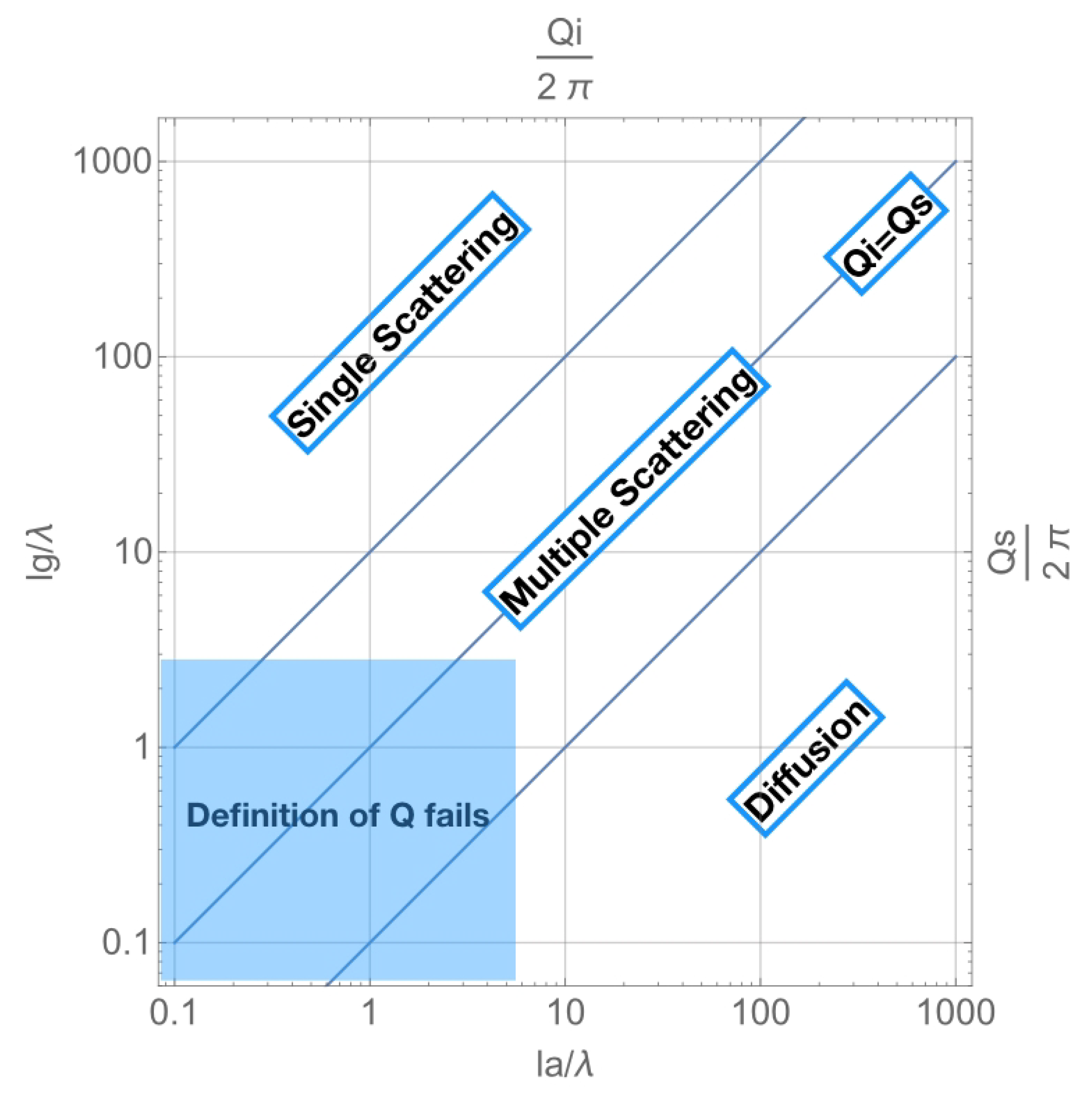
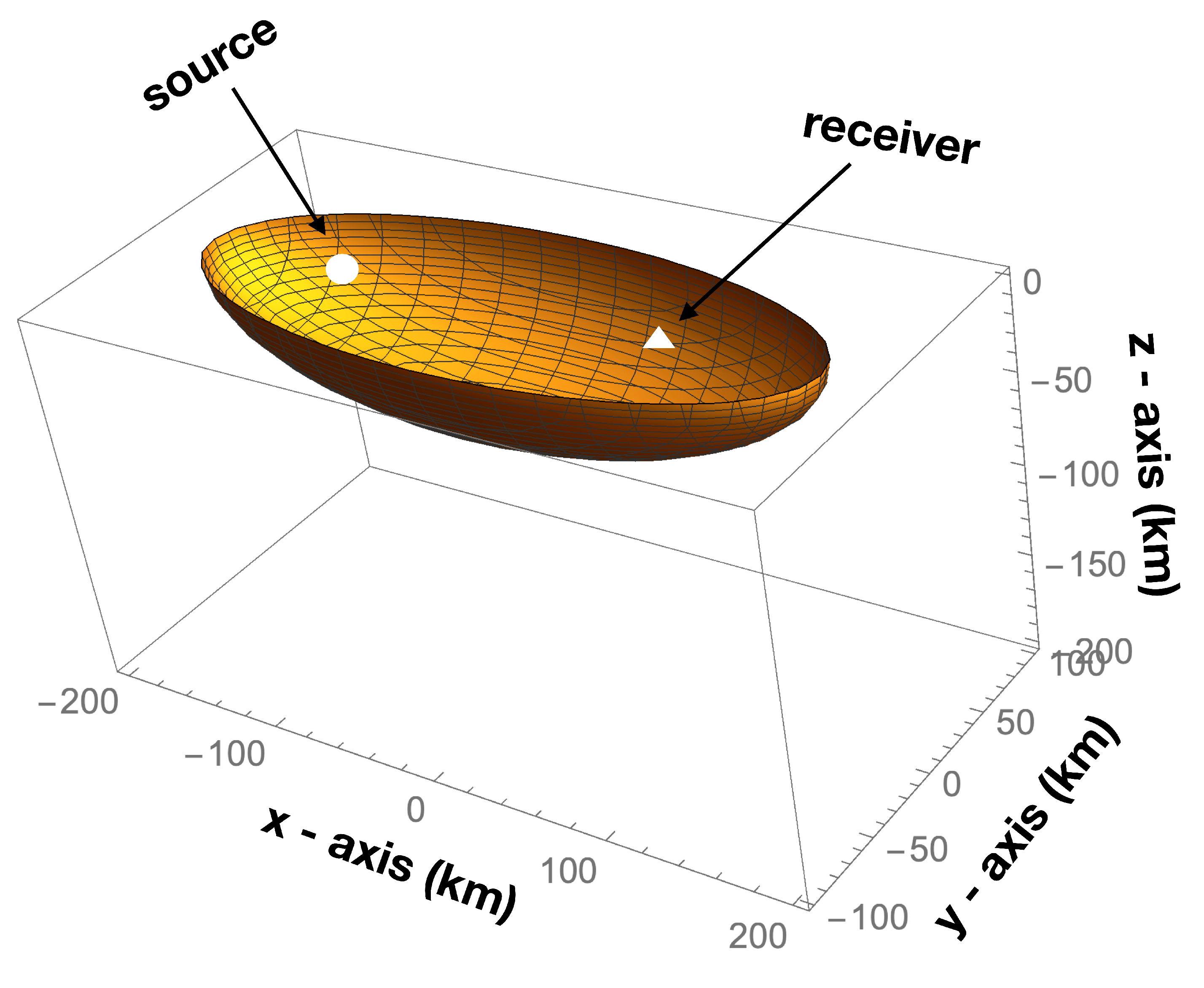
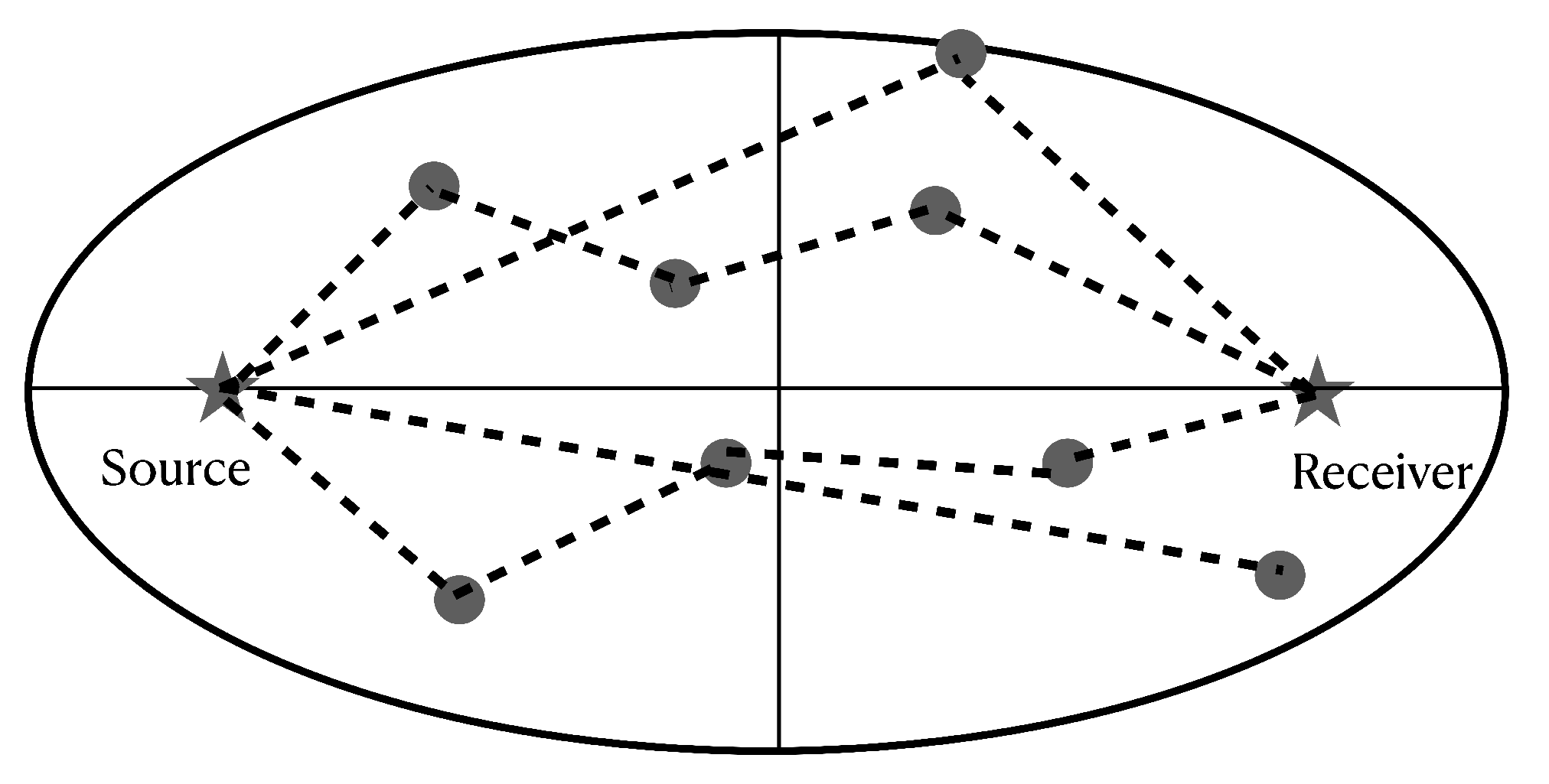
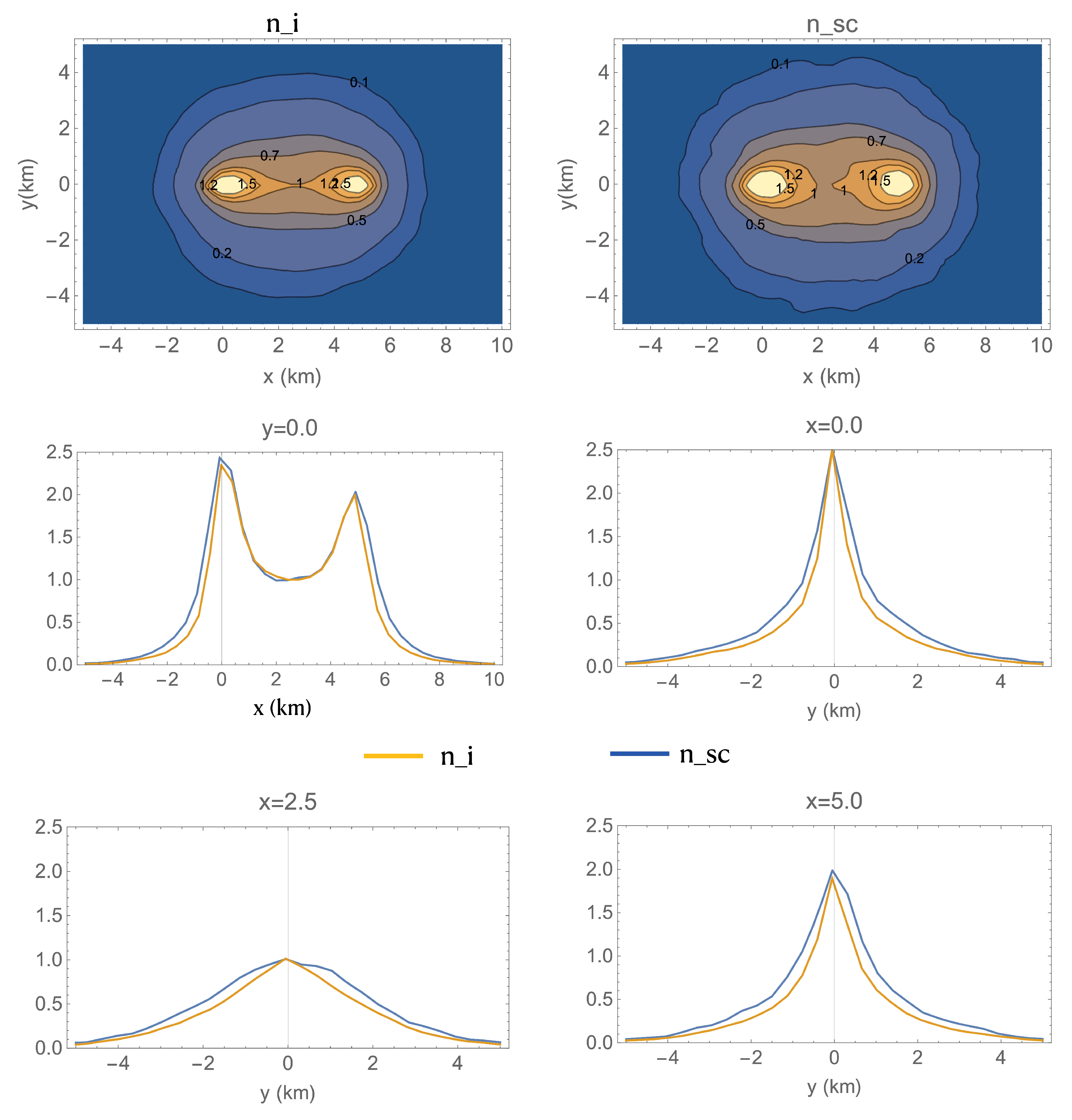
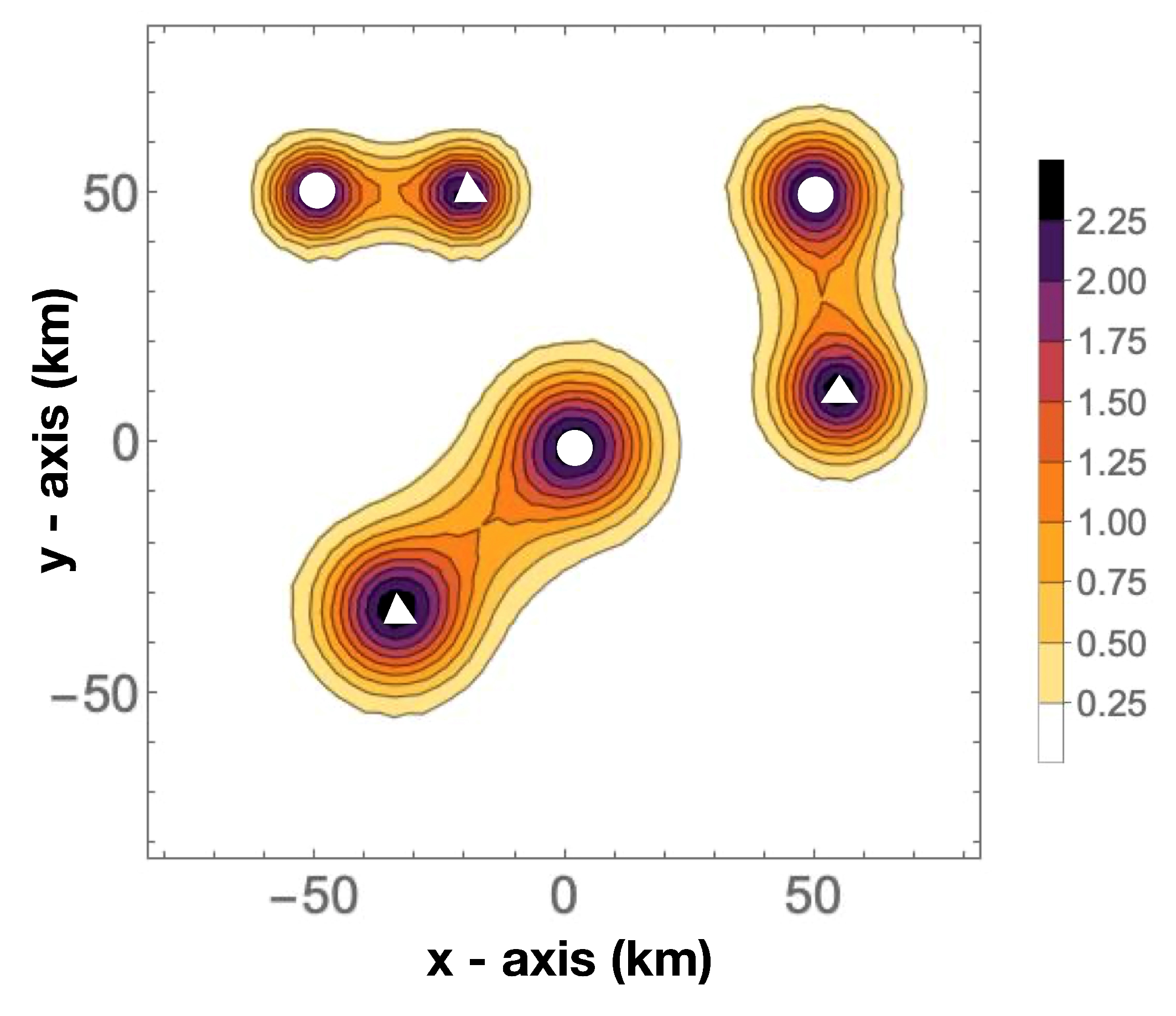

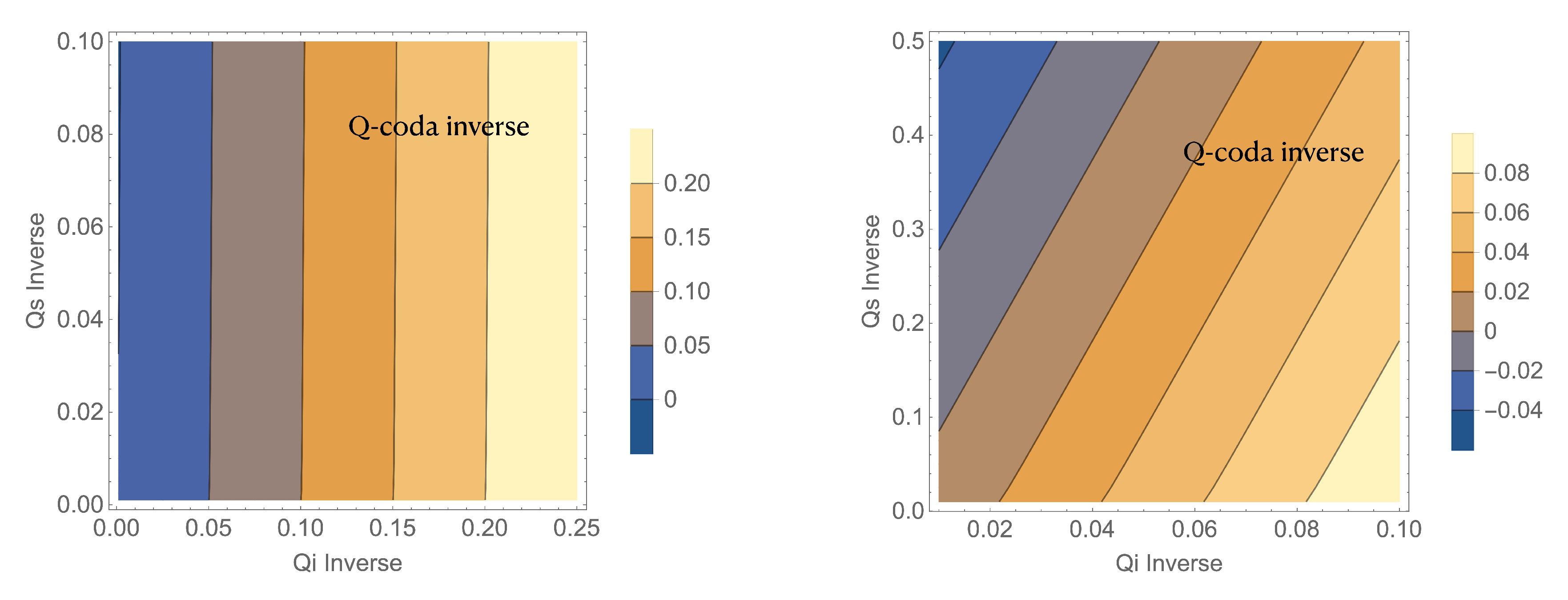
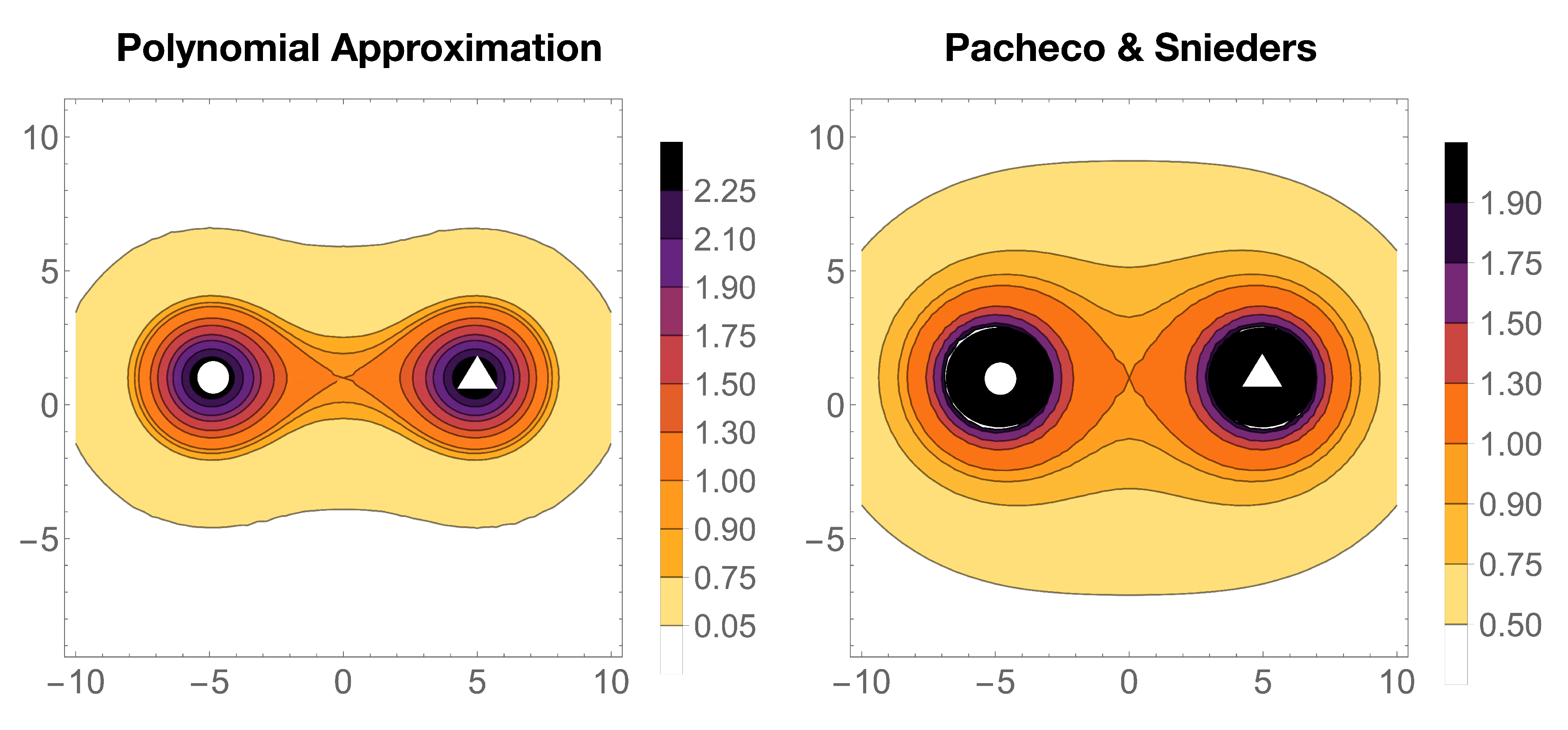
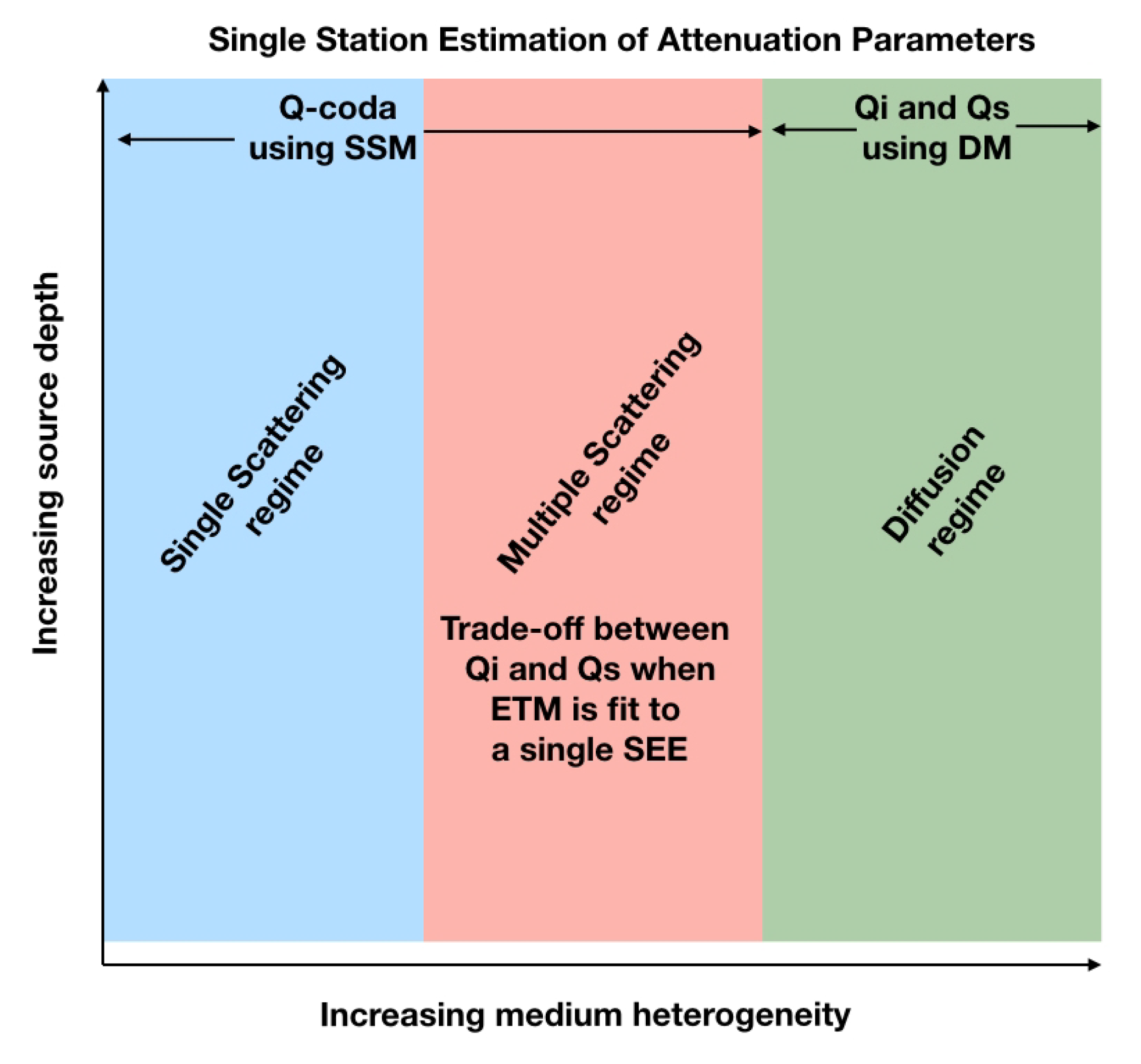
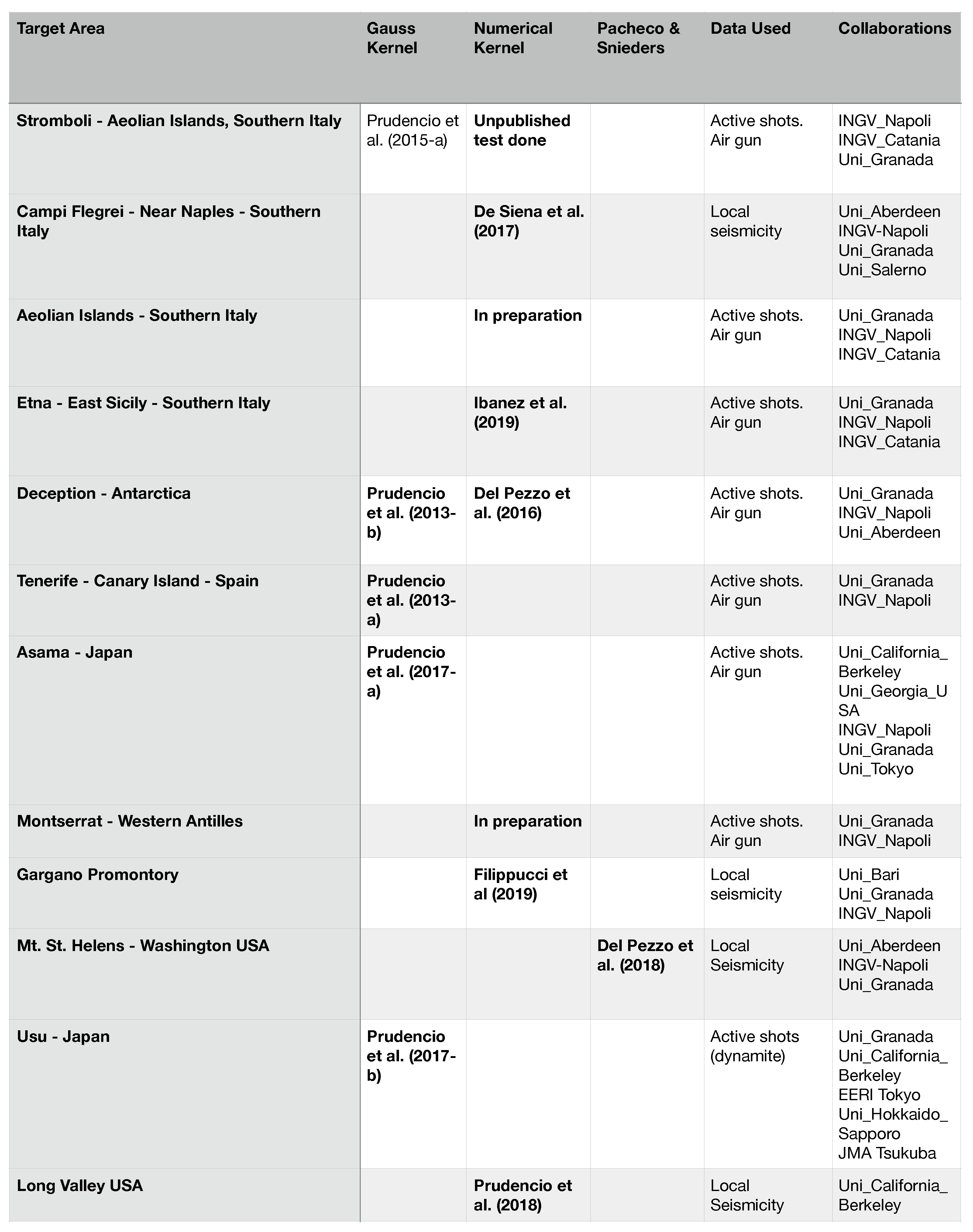
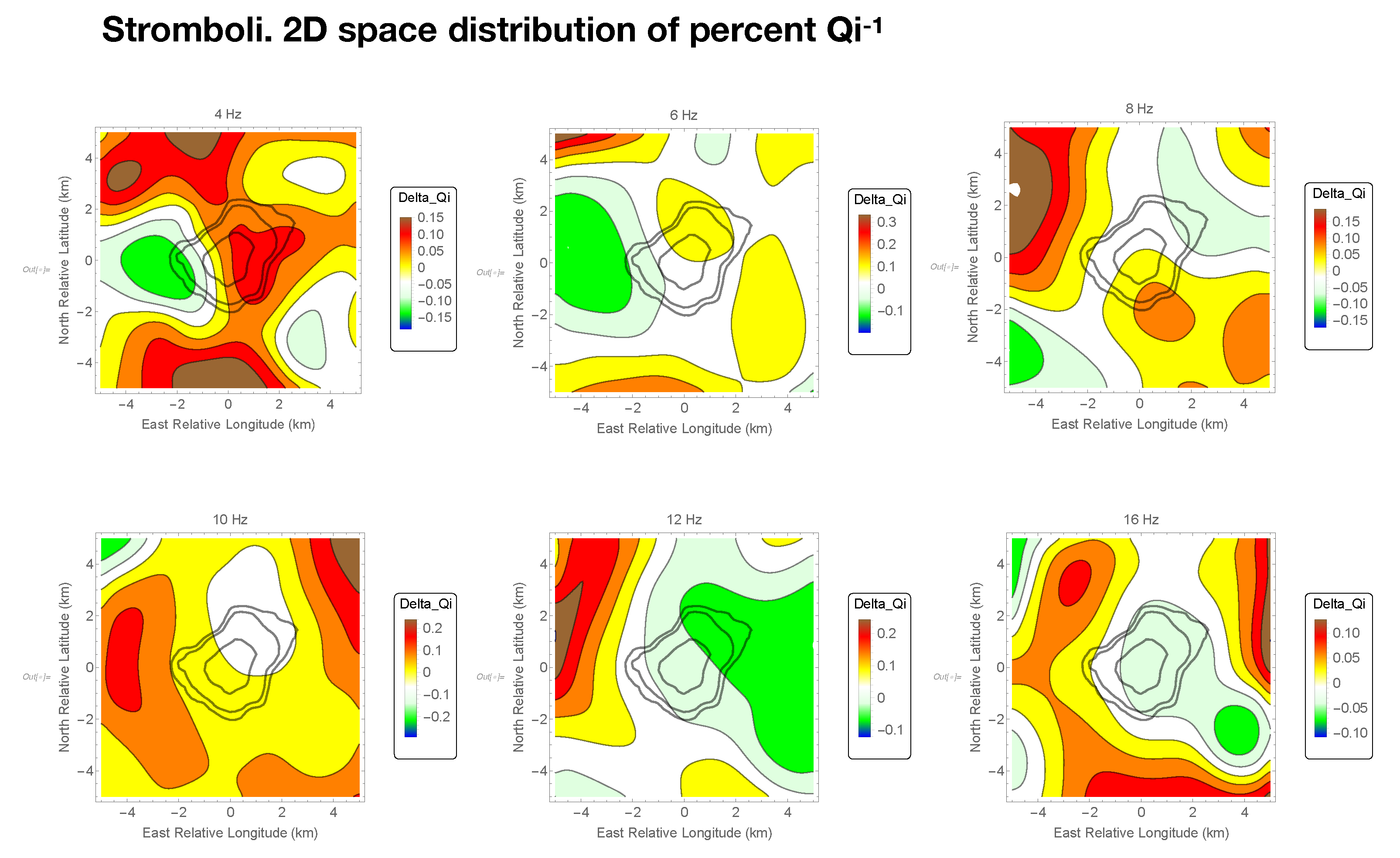
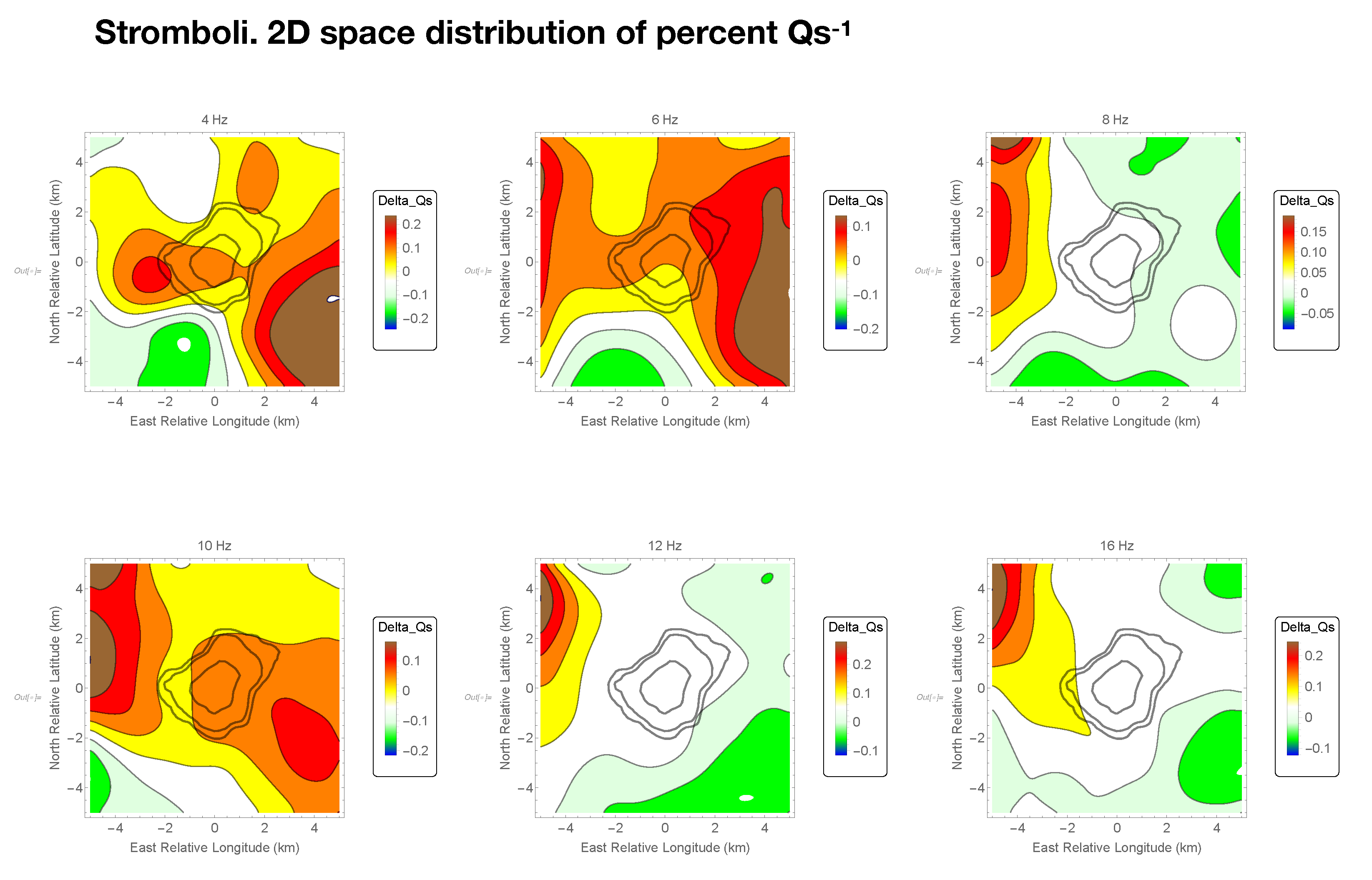

© 2020 by the authors. Licensee MDPI, Basel, Switzerland. This article is an open access article distributed under the terms and conditions of the Creative Commons Attribution (CC BY) license (http://creativecommons.org/licenses/by/4.0/).
Share and Cite
Del Pezzo, E.; Ibáñez, J.M. Seismic Coda-Waves Imaging Based on Sensitivity Kernels Calculated Using an Heuristic Approach. Geosciences 2020, 10, 304. https://doi.org/10.3390/geosciences10080304
Del Pezzo E, Ibáñez JM. Seismic Coda-Waves Imaging Based on Sensitivity Kernels Calculated Using an Heuristic Approach. Geosciences. 2020; 10(8):304. https://doi.org/10.3390/geosciences10080304
Chicago/Turabian StyleDel Pezzo, Edoardo, and Jesús M. Ibáñez. 2020. "Seismic Coda-Waves Imaging Based on Sensitivity Kernels Calculated Using an Heuristic Approach" Geosciences 10, no. 8: 304. https://doi.org/10.3390/geosciences10080304
APA StyleDel Pezzo, E., & Ibáñez, J. M. (2020). Seismic Coda-Waves Imaging Based on Sensitivity Kernels Calculated Using an Heuristic Approach. Geosciences, 10(8), 304. https://doi.org/10.3390/geosciences10080304




